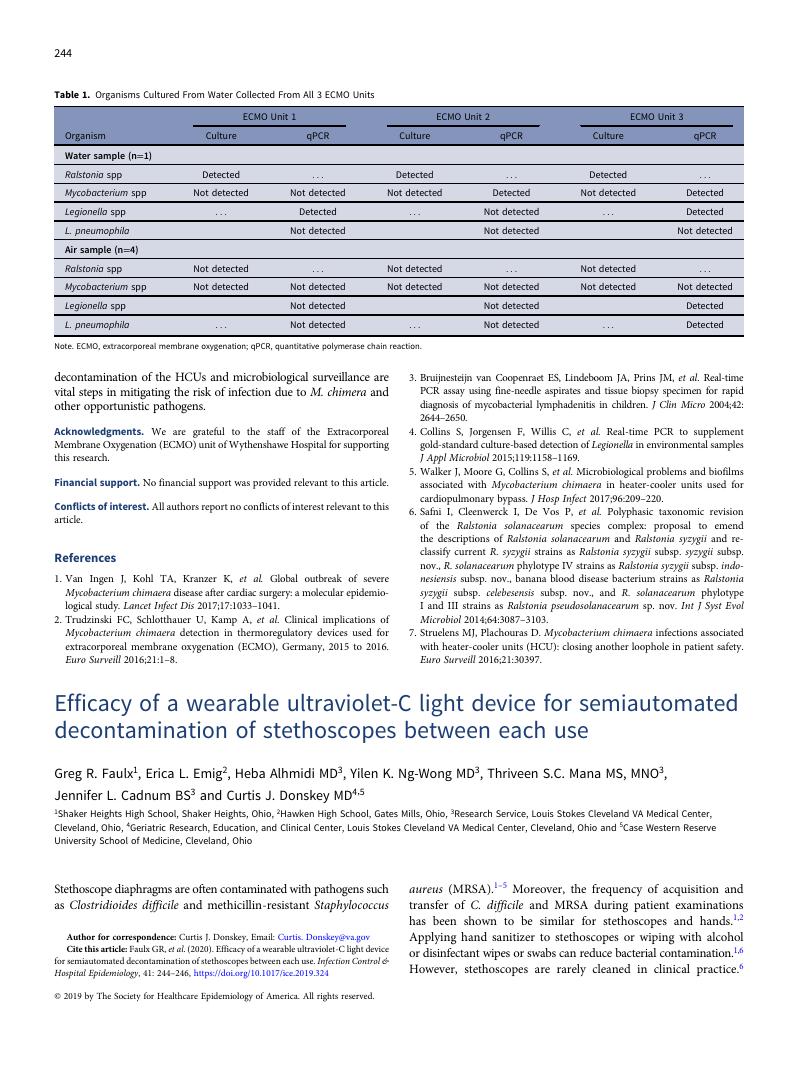No CrossRef data available.
Article contents
Efficacy of a wearable ultraviolet-C light device for semiautomated decontamination of stethoscopes between each use
Published online by Cambridge University Press: 05 December 2019
Abstract
An abstract is not available for this content so a preview has been provided. Please use the Get access link above for information on how to access this content.

- Type
- Research Brief
- Information
- Copyright
- © 2019 by The Society for Healthcare Epidemiology of America. All rights reserved.
References
Vajravelu, RK, Guerrero, DM, Jury, LA, Donskey, CJ.Evaluation of stethoscopes as vectors of Clostridium difficile and methicillin-resistant Staphylococcus aureus. Infect Control Hosp Epidemiol 2012;33:96–98.CrossRefGoogle ScholarPubMed
Longtin, Y, Schneider, A, Tschopp, C, et al.Contamination of stethoscopes and physicians’ hands after a physical examination. Mayo Clin Proc 2014;89:291–299.CrossRefGoogle ScholarPubMed
Cohen, S, McCormack, D, Youkhana, A, Wall, R.Bacterial colonization of stethoscopes and the effect of cleaning. J Hosp Infect 2003;55:236–237.CrossRefGoogle ScholarPubMed
Alleyne, S, Hussain, A, Clokie, M, Jenkins, D.Stethoscopes: potential vectors of Clostridium difficile. J Hosp Infect 2009;73:187–189.CrossRefGoogle ScholarPubMed
Knecht, VR, McGinniss, JE, Shankar, HM, et al.Molecular analysis of bacterial contamination on stethoscopes in an intensive care unit. Infect Control Hosp Epidemiol 2018;18:1–7. doi: 10.1017/ice.2018.319Google Scholar
Mehta, AK, Halvosa, JS, Gould, CV, Steinberg, JP.Efficacy of alcohol-based hand rubs in the disinfection of stethoscopes. Infect Control Hosp Epidemiol 2010;31:870–872.CrossRefGoogle ScholarPubMed
Messina, G, Burgassi, S, Messina, D, Montagnani, V, Cevenini, G.A new UV-LED device for automatic disinfection of stethoscope membranes. Am J Infect Control 2015;43:e61–e66.CrossRefGoogle ScholarPubMed
Designation E2197: Standard Quantitative Disk Carrier Test Method for Determining Bactericidal, Virucidal, Fungicidal, Mycobactericidal, and Sporicidal Activities of Chemicals. West Conshohocken, PA: ASTM International; 2011.Google Scholar
Shaikh, AA, Ely, D, Cadnum, JL, et al.Evaluation of a low-intensity ultraviolet-C radiation device for decontamination of computer keyboards. Am J Infect Control 2016;44:705–707.CrossRefGoogle ScholarPubMed
Schmidt, MG, Tuuri, RE, Dharsee, A, et al.Antimicrobial copper alloys decreased bacteria on stethoscope surfaces. Am J Infect Control 2017;45:642–647.Google ScholarPubMed




